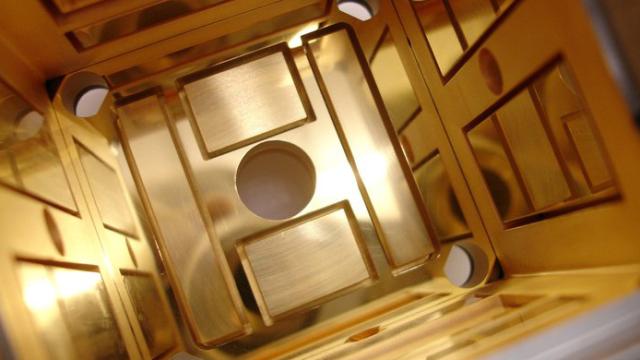On December 3, the LISA Pathfinder, humanity’s first bold attempt to hunt for gravitational waves from outer space, blasted into orbit. Two months and a million kilometres later, the first phase of LISA Pathfinder’s scientific operations has begun.
In what’s being called a “major milestone“, the LISA pathfinder spacecraft released both of its gold-platinum test masses today. The simple and elegant goal of the experiment is to keep these shiny cubes suspended in perfect free fall, measuring their positions with breathtaking precision. Isolated from cosmic radiation and the solar wind, the masses will only move if jostled by the spacetime ripples known as gravitational waves.
“LISA Pathfinder continues to work perfectly,” said Karsten Danzmann, director at the Max Planck Institute for Gravitational Physics. “Releasing the test masses required some learning, but the team quickly found a smooth solution. The successful operation of a laser interferometer in space with two free falling test masses is a world first!”
In news that both figuratively and literally shook the world, physicists at the Laser Interferometer Gravitational Wave Observatory announced the first direct detection of gravitational waves last week, confirming the final prediction of the theory of general relativity penned by Albert Einstein a century ago. This is the beginning of the age of gravitational wave science, and a whole new way of studying the universe. In the months and years ahead, LIGO will continue to hunt for gravitational waves produced by colliding black holes and neutron stars, shedding new light on these mysterious celestial objects.
Meanwhile, LISA Pathfinder represents the first phase of a complementary effort to search for gravitational waves in space. While this particular experiment isn’t expected to detect gravitational waves during its months-long science operation, the spacecraft is testing fundamental technologies that will allow us to scale up to a large, space-based gravitational wave observatory. Freed from the spatial constraints and noisy bustle of a small planet, scientists hope to cast a wider net for gravitational waves in space, searching for the shockwaves caused by the violent collision of supermassive black holes at the centres of galaxies.
The release of LISA Pathfinder’s two test masses is the first step toward all of that glorious science. The 46mm gold cubes are separated by a mere 38cm. Between them sits a laser interferometer, which will attempt to measure their position with precision of up to about a hundred millionth of a millimetre. If that can be done, we’ll have a shot at watching the test masses bob, like surfers on a swell, as gravitational waves sweep through our solar system.
LISA Pathfinder’s full scientific operations are expected to begin in early March. Keep your ears open — the universe is just starting to speak to us.
Top image: Electrode housing chamber where the first outer space tests for gravitational waves will take place.Via CGS / SpA.
